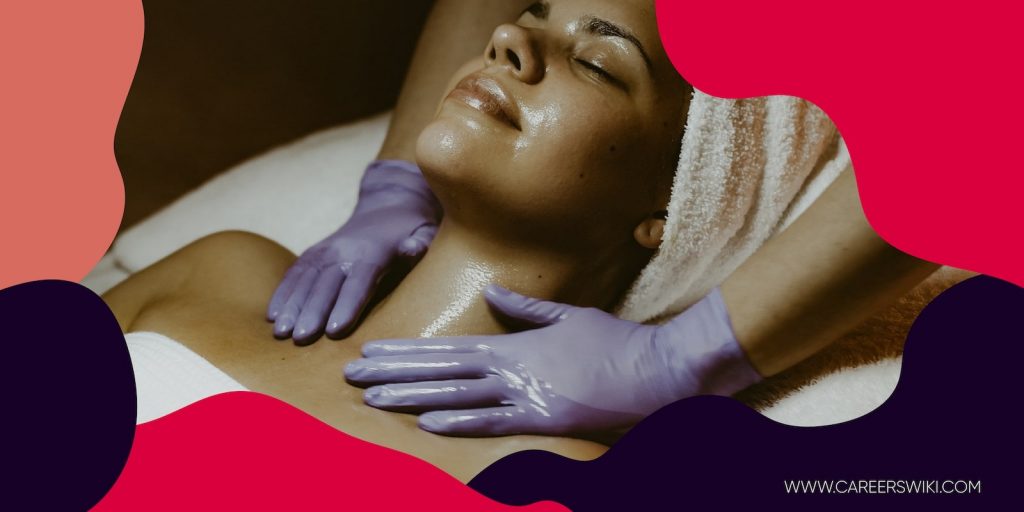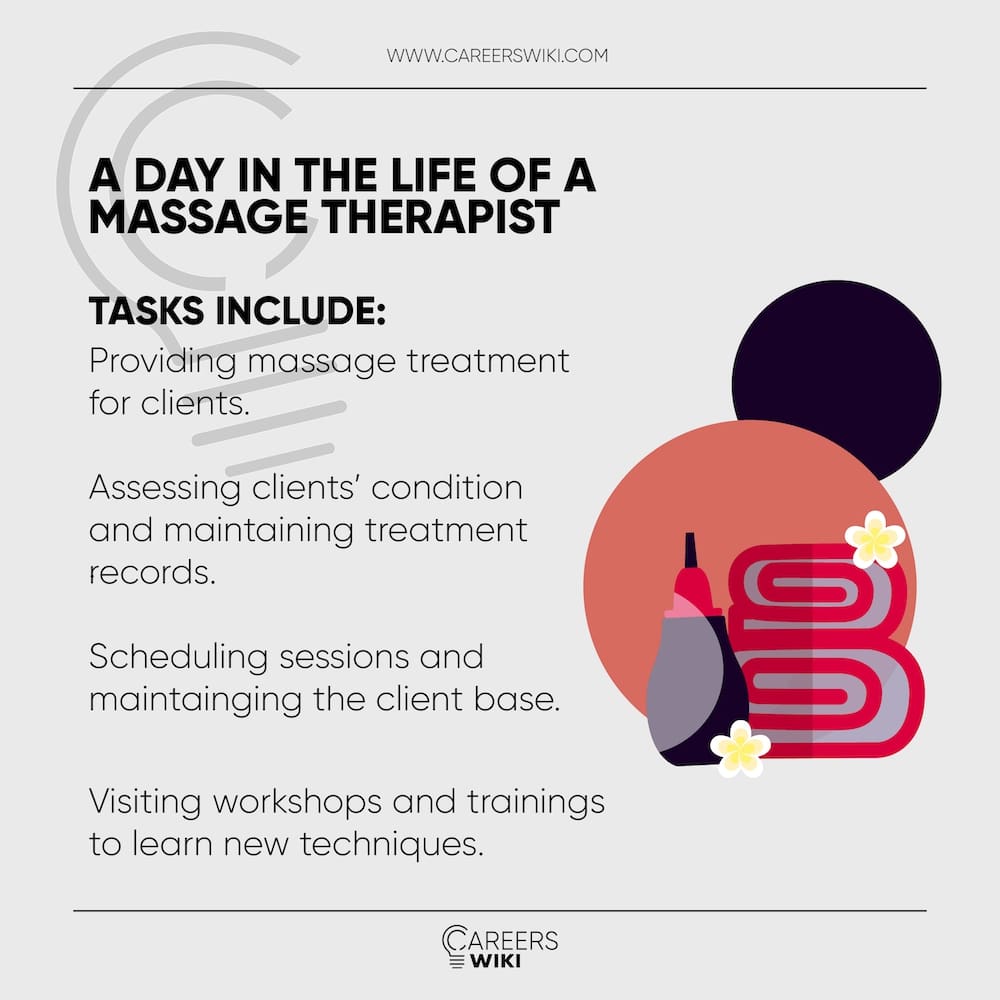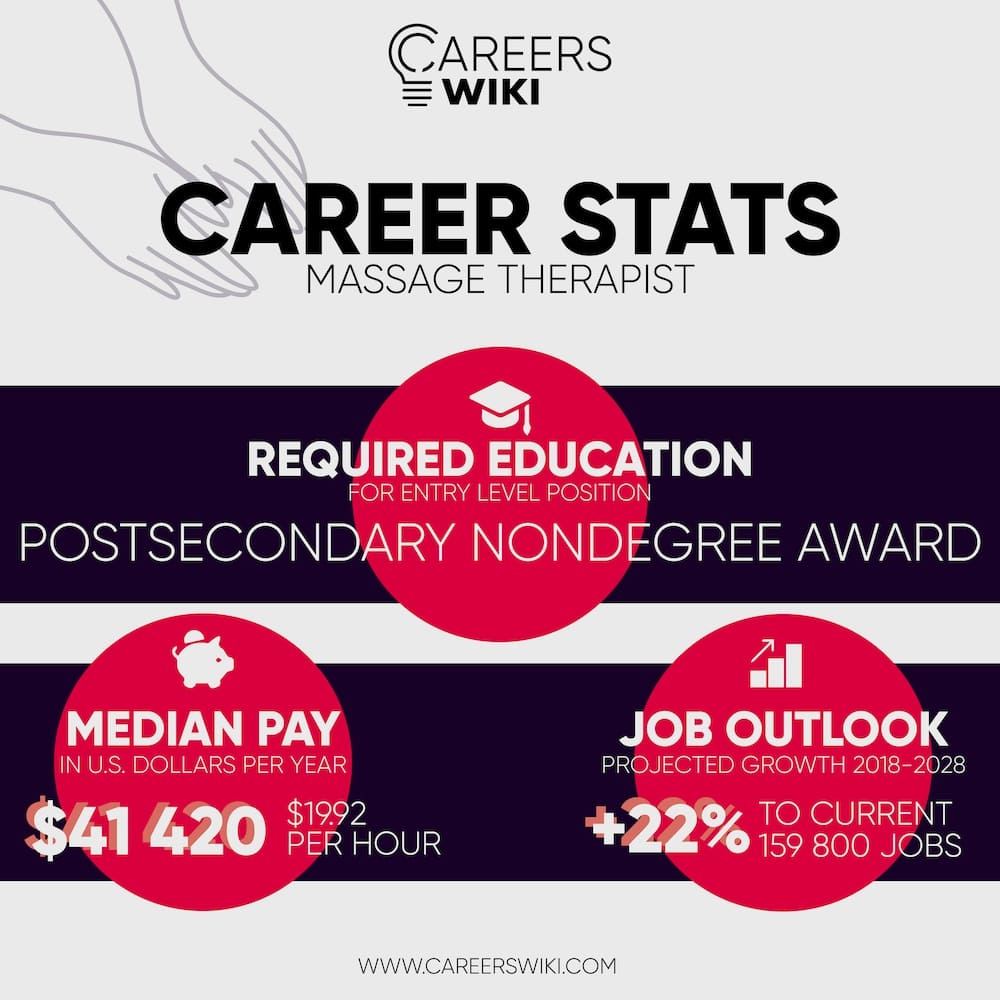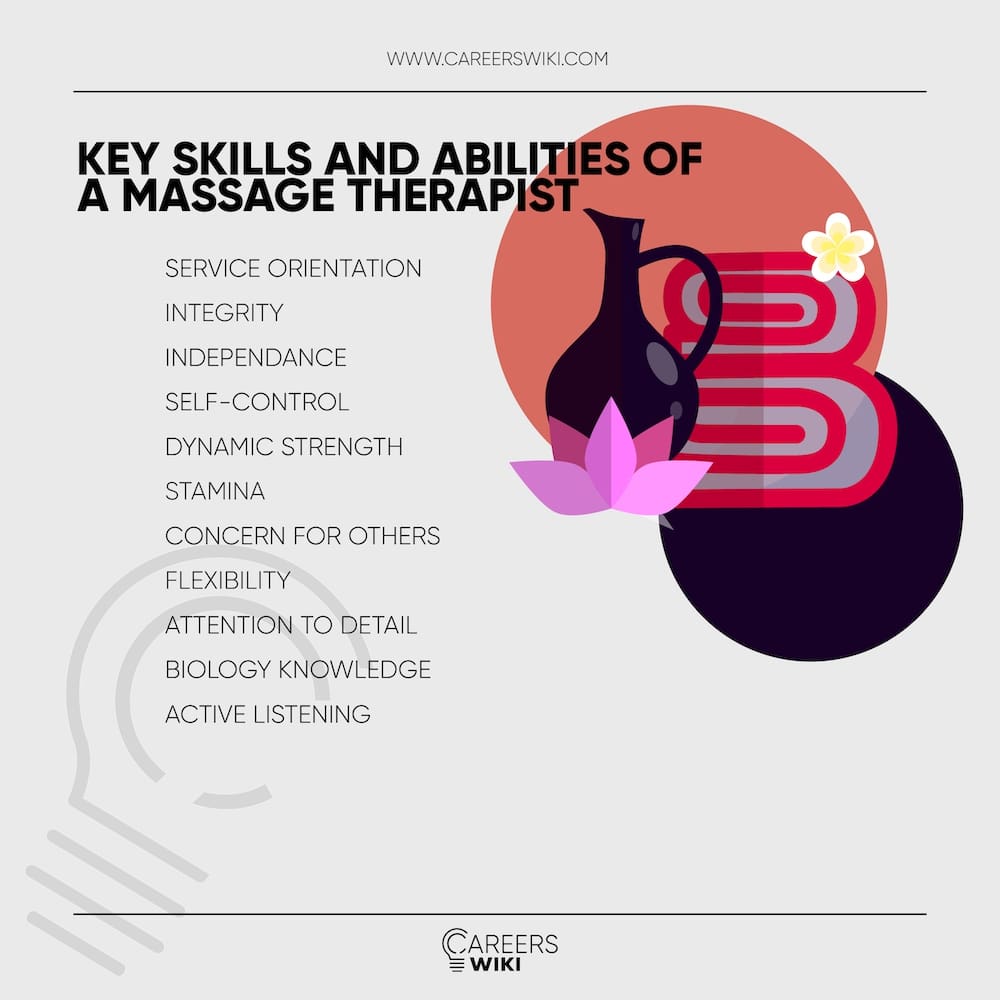Job Titles: Bodywork Therapist, Certified Massage Therapist (CMT), Clinical Massage Therapist, Integrated Deep Tissue Massage Therapist, Licensed Massage Practitioner (LMP), Licensed Massage Therapist, Massage Therapist, Medical Massage Therapist, Registered Massage Therapist, Therapeutic Massage Technician [1].

Massage therapists are professionals who use touch and massage to manage injuries, relieve pain, improve circulation, relieve stress, and increase relaxation and general wellness of clients. Massage therapists use a variety of massage modalities to administer care to their clients.
Massage therapists work directly with clients to improve their personal well-being. As such, it is a very meaningful career in which one builds personal relationships with their clients.
In fact, our anonymous survey concluded that over 80% of massage therapists are satisfied with their job.
Massage therapy is a fast-growing profession and more people than ever are taking advantage of the therapeutic effects of massages.
Massage therapists typically work on a per-client basis so their schedules are irregular and flexible.
Many massage therapists are self-employed and some run their own salons or spas.
Massage therapy is also a high stability career as more people are looking for therapeutic methods of relaxation.
All of these factors go together to make massage therapy a highly satisfying career.
Typical Day of a Massage Therapist

Massage therapists have very flexible and irregular work schedules so there is no “typical” day for a massage therapist. Most of the time, a massage therapist’s day is split between working with clients and scheduling appointments with other clients.
Some massage therapists will also spend part of their day going to training and workshops to learn new techniques. Since their work is mostly on a per-client basis, the amount of work you do each day depends on how many clients you have.
Pros & Cons of Being a Massage Therapist
- Flexible scheduling
- Relatively cheap education costs compared to similar professions
- Good mid-level salaries
- Many job opportunities
- High job satisfaction
- Good potential for career growth
- It takes time to get off the ground. Even if you are employed at a salon it takes time to build up a clientele and get regular sessions.
- Irregular work schedules and periods of no work
- If you are self-employed, finding clients requires a lot of effort on your part
- You usually must pay for your own supplies in massage therapy school
Work Environment
The majority of massage therapists are self-employed [2].
Typically, massage therapists rent out a studio where they can provide clients with their services.
Some massage therapists make home visits as well, and some work out of their own homes.
Generally, self-employed massage therapists must acquire their own work materials including lotions, oils, massage beds, sheets, and pillows.
The typical massage therapist works on a per-client basis so their schedule is constantly changing and involves working nights and weekends.
Working conditions depend heavily on the venue. Relaxation massage may be performed in a dimly lit room with candles and incense, while a rehab massage may be performed in a well-lit room with multiple other people receiving the same treatment.
Since many massage therapists are self-employed, a good chunk of time is spent attending to business-related matters.
Massage therapy is not a particularly high-impact career but there are some potential risks. Giving a massage can be physically demanding so massage therapists are at risk of fatigue and muscle injury from repetitive motion and standing for long periods of time.
Opportunities & Job Outlook

As of 2018, there were 150,800 massage therapy jobs nationwide. California and Florida were the two states with the most massage therapist jobs at 15,200 and 9,620 respectively [3].
Massage therapy employment is expected to grow by 22% from 2018 to 2028, significantly much faster than the national average for other careers [4].
As more and more states adopt standards and regulations for massage therapists, the profession is likely to become seen as more legitimate and sophisticated.
Additionally, demand for the position is expected to grow as more people learn about the therapeutic benefits of massage therapy. The continued expansion of clinical massage therapy enterprises will also increase the number of jobs.
Referrals are an important part of massage therapy work so it may take some time for clients to build clientele, strong contacts, and good relations.
Massage therapists can attract more clients by completing certification programs for multiple massage modalities.
Median Pay
The annual median salary for massage therapists in 2018 was $41,420 ($19.92/hour) [5].
The top 10% of earners made more than $78,280 while the bottom 10% of earners made less than $21,340.
Those employed in the offices of chiropractors saw the highest average salaries at $51,690, while those who work in accommodation services saw the lowest salaries at $28,020.
Many massage therapists also receive cash tips and gifts, so BLS data may not represent the entirety of income potential for massage therapists.
Typical Entry-Level Education
Most massage therapists (57%) have either a certificate or associate’s degree [6] through some post-secondary institution, though some states allow massage therapists to work without a formal education. Massage therapy programs are offered at vocational schools, technical colleges, and some universities.
Education Cost vs Salary
The typical massage therapy certificate program can cost anywhere between $5,000-$10,000 and usually require 500-600 hours of coursework. Most programs require students to buy their own supplies and equipment which can total another $500-$1,000
In other words, the average massage therapy training program costs about a quarter of the median salaries for employed professionals in the field.
Since massage therapists work on a per-client basis, it can take a few years for them to build up a reputation and get regular work. Most massage therapists start out making ~$20,000-$25,000 a year; a fairly decent return on the educational investment. Again, these figures may not represent the total income massage therapists receive as they often get cash tips and gifts.
Compare this to the average PTA salary. The average PTA makes about $48,000 annually [7], and PTA’s and massage therapists both require some postsecondary education. However, PTA school is usually more expensive than massage therapy programs with an average 2-year cost of $40,086. In other words, a 2-year PTA program can cost up to 4 times the tuition cost for a certificate in massage therapy.
Athletic trainers also make a similar salary to massage therapists [8], but the profession usually requires a bachelor’s degree in the subject. Also, a 4-year athletic trainer program has an average tuition cost of $150,648, much more expensive than massage therapy programs.
The same holds true for exercise physiologists; they make a similar median salary to massage therapists but the field requires a bachelor’s degree [9].
The average bachelor’s program in exercise physiology has an annual tuition cost of $42,459 with an average 4-year cost of $169,836, significantly more expensive than a massage therapy certificate program.
Massage Therapist Job Description
Massage therapists specialize in the administration of massage techniques meant to treat injuries, relieve pain and stress, align the spine, and promote general wellness and satisfaction.
Massage therapists not only specialize in physical massage but also aromatherapy and in some cases acupuncture or other alternative forms of medicine. Overall, massage therapists are healthcare providers who specialize in the healing/rehabilitative power of touch and massage.

Work Styles
- Concern for others: Massage therapy is primarily a care-oriented discipline so massage therapists must be sensitive to other needs, feelings, and be understanding.
- Self control: Massage therapists need to have good control and organizational skills to manage their schedules. They have to keep their emotions in check, control anger, and avoid aggressive behavior.
- Attention to detail: Massage therapy requires precise attention to detail to properly work on clients. They must be thorough in completing their tasks.
- Independence: Most work is done independently and you will have to find clients on your own. Many massage therapists run their own salons so they need to know how to run an independent business.
- Integrity and ethics: Massage therapists must abide by a code of professional ethics and be dedicated to their client’s well-being.
Work Values
- Punctuality: Clients must be met in a timely and punctual manner.
- Flexibility: Massage therapists work irregular schedules that are constantly shifting. The ideal massage therapist likes a flexible environment where work requirements shift from day-to-day.
- Independence: Massage therapists are highly independent and like doing things on their own.
- Recognition: As a massage therapist, you will receive recognition from your clients and their referrals.
- Good relationships: Massage therapists create meaningful and lasting relationships with clients. Since health is an intimate part of human experience, many massage therapists form intimate bonds with their clients.
- Social interaction: Virtually the entirety of the profession is social interaction with others. The ideal massage therapist is an extrovert who gains energy from being around others.
Interests
- An interest in human health and wellness: Massage therapy is primarily about promoting health and wellness. A massage therapists’ practice should revolve around these concerns.
- An interest in human anatomy/physiology: You will be working with the human body and must know how the human body works and reacts to stimuli. Further, massage therapists must take the initiative to get an education and learn more specialized techniques that require a more precise understanding of human anatomy, like deep tissue massages or sports massage.
- An interest in helping others: Massage therapy above all else is a care-oriented discipline so massage therapists should be interested in helping others.
- Desire to promote mental well-being: Massage therapists also promote psychological well being with their therapeutic techniques. An acute awareness of mental health and mental health needs is required for the job.
Similar Occupations Compared
| Athletic Trainers | Athletic trainers specialize in preventing injury during and maximizing the effectiveness of exercise. The profession requires a bachelor’s degree. |
| Physical Therapy Assistants | PTAs work with physical therapists to give patients rehabilitative services. PTAs require an associate’s degree or higher to work and they have lower average salaries than massage therapists. |
| Exercise Physiologists | Exercise physiologists develop fitness and exercise programs. The profession requires a bachelor’s degree. |
- “Summary Report for: 31-9011.00 – Massage Therapists.” O*NET OnLine, https://www.onetonline.org/link/summary/31-9011.00. [↑]
- “Massage Therapists : Occupational Outlook Handbook.” U.S. Bureau of Labor Statistics, U.S. Bureau of Labor Statistics, 4 Sept. 2019, https://www.bls.gov/ooh/healthcare/massage-therapists.htm#tab-3. [↑]
- “Massage Therapists : Occupational Outlook Handbook.” U.S. Bureau of Labor Statistics, U.S. Bureau of Labor Statistics, 4 Sept. 2019, https://www.bls.gov/ooh/healthcare/massage-therapists.htm. [↑]
- “Massage Therapists : Occupational Outlook Handbook.” U.S. Bureau of Labor Statistics, U.S. Bureau of Labor Statistics, 4 Sept. 2019, https://www.bls.gov/ooh/healthcare/massage-therapists.htm#tab-6. [↑]
- “Massage Therapists : Occupational Outlook Handbook.” U.S. Bureau of Labor Statistics, U.S. Bureau of Labor Statistics, 4 Sept. 2019, https://www.bls.gov/ooh/healthcare/massage-therapists.htm#tab-5. [↑]
- “Summary Report for: 31-9011.00 – Massage Therapists.” O*NET OnLine, https://www.onetonline.org/link/summary/31-9011.00#Education. [↑]
- “Physical Therapist Assistants and Aides : Occupational Outlook Handbook.” U.S. Bureau of Labor Statistics, U.S. Bureau of Labor Statistics, 4 Sept. 2019, https://www.bls.gov/ooh/healthcare/physical-therapist-assistants-and-aides.htm#tab-1. [↑]
- “Athletic Trainers : Occupational Outlook Handbook.” U.S. Bureau of Labor Statistics, U.S. Bureau of Labor Statistics, 4 Sept. 2019, https://www.bls.gov/ooh/healthcare/athletic-trainers.htm. [↑]
- “Exercise Physiologists : Occupational Outlook Handbook.” U.S. Bureau of Labor Statistics, U.S. Bureau of Labor Statistics, 4 Sept. 2019, https://www.bls.gov/ooh/healthcare/exercise-physiologists.htm. [↑]
